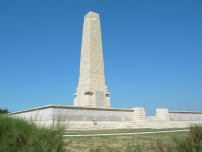| First Name: | Alfred | Last Name: | BARNES | |
|---|---|---|---|---|
| Date of Death: | 07/08/1915 | Lived/Born In: | Regent's Park | |
| Rank: | Private | Unit: | Worcestershire9 | |
| Memorial Site: | Helles Memorial, Gallipoli | |||
Current Information:
On 25 April, British, Australian and New Zealand forces landed on the Gallipoli peninsula. The plan was that these forces would soon defeat a demoralised Turkish army, knock Turkey out of the war, open up the Mediterranean to the Russian navy and threaten Austro-Hungary from the south. None of these things were achieved despite nine months of hard fighting in terrible conditions. It was an heroic failure. By July, 1915, and after much fierce fighting, stalemate had set in at Gallipoli both at Cape Helles where the British and French had landed and at Anzac Cove where the Australian and New Zealand Corps were unable to break out of their beach head. Fresh troops were needed and they were on their way in the shape of four divisions from Britain and things were put on hold until they arrived. The plan for August was for a landing at Suvla Bay to the north of Anzac Cove whilst at the same time, the ANZAC Corps, reinforced by some of the new British troops would effect a breakout from Anzac Cove and establish a line across the peninsula. Whilst this was going on the troops in the south at Helles would stage a number of diversionary attacks. But it all went horribly wrong and much of the reason for this can be explained by inadequate planning and leadership. Nobody seemed to know what they were supposed to be doing and Lieutenant-General Stopford, in charge of the Suvla landings was particularly out of his depth. The landings at Suvla failed to link up with the forces at Anzac and the breakout from there did not happen despite valiant efforts by all concerned. The loss of life on all fronts was again enormous. L.A. Carlyon’s excellent book “Gallipoli” gives a superb yet chilling account of the events. The 13th Division, including the 9th Worcestershire battalion of 39 Brigade, arrived at Helles in July, 1915. 13th Division had been chosen to assist in the breakout from Anzac Cove during the August attack and on 3rd August they moved to this location in preparation. 9th Worcestershire were part of the second column of the left attacking force which would make their way northwards up the coast before turning inland to attack the heights of Sari Bair from the north with the objective of capturing Hill 971. On the night of 6/7th August 9th Worcestershire began their advance by moving past Plugge’s Plateau to the mouth of Reserve Gully and by dawn had reached the Aghyl Dere valley. They began making their way across extremely difficult terrain toward Hill Q, their first objective, which they were due to attack that evening. The men were extremely tired and Turkish snipers in the surrounding hills further impeded their progress so that by the end of the day they had not reached their destination and halted for the night, some way short of it. Among their casualties on this trying day was Alfred Barnes. |
||||
| « Back to Search Results | ||||
| If you think any of the information shown here is incorrect, Click Here to submit your amends and comments | ||||




